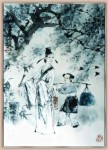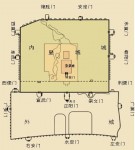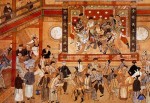Repertoire of Erhu Melody: Two Springs Reflect the Moon
Erhu, also called Huqin, was known as Xiqin during the Song Dynasty. Huqin described in Yuan Dynasty records was the real forerunner of the modern Erhu, having its stem, sound box and pegs made of wood. The sound box can be round, hexagonal or octagonal, with one end covered with snakeskin, sometimes from a python, and the other end, an ornamentally carved sound vent. There are two strings, played with a bamboo bow with horsetail hairs passing behind the strings. The range is normally five octaves, and sometimes four in special cases. In modern times, many people have made innovations to improve the tone color of Erhu.
The most widespread piece of Erhu music in China is Two Springs Reflect the Moon, composed by the Wuxi folk artist Ah Bing, whose original name was Hua Yanjun, in the mid 20th century. This work has two themes, which complement and intertwine, and finally melt into each other subtly and smoothly. Step by step and variation upon variation, the two themes rise and fall effortlessly. The crescendos especially show the composer’s steely and unyielding spirit.
There is a profound range of feeling in this piece, which incorporates a majestic spirit within a tightly knit composition. Vigorous variations in bowing technique make full use of the five hand positions, and the result is a fiercely emotional coloring expressing of the composer’s suppressed grief at having tasted to the full the bitterness of life in the old society. Two Springs Reflect the Moon is an exquisite example of Chinese instrumental folk music stemming from the heart of a small-town folk artist.
Two Springs Reflect the Moon (Er-Quan-Ying-Yue) :
[audio:erquanyingyue.mp3]
If you want to listen the music online, it will take your some minutes to begin.
High Mount Flowing Water(Gao-Shan-Liu-Shui)
During the Spring and Autumn Period (770-476BC), there was a man called Yu Boya, who was a famous music master at that time, having a good command of the temperament and superb skills in playing the musical instrument.
Once, on the 15th day of the 8th lunar month, Boya was boating for sightseeing. The moon was bright and a cool breeze was blowing gently. With myriads of thoughts welling up in his mind, he began to play the musical instrument. The melodious music became more and more beautiful when a man on the bank shouted “bravo!” Hearing the shouting, Boya came out of the boat, and saw a woodcutter standing on the bank. He knew that this man was keenly appreciative of his talents, because he understood his music. He immediately invited the woodcutter to his boat and, full of zest, he played the musical instrument for him. When Boya played a piece of music eulogizing the high mountains, the woodcutter said, “Wonderful! The melody is as magnificent and dignified as Mount Tai which reaches the sky!” When he played a piece of music depicting the turbulent waves, the woodcutter said, “Wonderful! The melody is as vast and mighty as the great rivers!” Boya was excited, and said, “Bosom friend! You are really my bosom friend!” That woodcutter was Zhong Ziqi. Since then, they had been very good friends.
High Mount Flowing Water played by Boya was divided into two parts later, one is High Mountains, and the other is Flowing Water.
America sent out two spacecraft on August 20 in 1977. Expecting to meet humankind in other planets, the spacecraft carried a gold-painted bronze record consisting of 27 pieces of world famous music. Flowing Water was chosen to represent Chinese music in that record.
[audio:gaoshanliushui.mp3]If you want to listen the music online, it will take your some minutes to begin.
The Butterfly Lovers – Violin Concerto
If you want to listen the music online, it will take your about one  minute to begin. We are sorry, we have no enough time to optimize the speed.
minute to begin. We are sorry, we have no enough time to optimize the speed.
[audio:butterflylovers.mp3]
The music of Liang Zhu, or “Butterfly Lovers,” is undoubtedly the best-known and most popular in all of China. It is also one of the few Chinese pieces that have often appeared on the international stage. Almost everyone in China can hum a few lines of the violin concerto, which can be traced to a Chinese folk legend “Liang Shanbo and Zhu Yingtai”.
According to the legend, Zhu Yingtai assumes a male identity so she may travel to study in Hangzhou, a southern city in China, where she meets Liang Shanbo. In the course of their studies, Zhu and Liang become very close friends. From a Confucian perspective, the notion of “Junzi” (gentleman) is a well-exemplified ideal in Chinese history and its quality and characteristics are well expounded upon by Confucian scholars. Basically, this implies the highest integrity, morality and demeanor, coupled with well-refined abilities and skills both in martial arts and academia — the kind of relationship that Zhu and Liang had achieved. When the time came for Zhu to return home, the pair is overcome with much suppressed sadness. Zhu offers her younger sister’s hand in marriage and entreats Liang to visit her residence to discuss the issue with her parents. Liang is unaware that Zhu is female nor that she does not have a younger sister. (She is, in fact, offering her own hand in marriage.)
A year passes before Liang makes his way to Zhu’s residence. He is overjoyed to realize Zhu’s true identity and that she is in love with him. However, happiness turns into sorrow as the two soon discover that Zhu has been betrothed to another man. In great sadness, the two lovers meet at the tower and lament their great misfortune. Upon his return to Hangzhou, Liang falls ill in his great misery and dies. When Zhu hears of this on her wedding day, she flees to his grave. There, legend has it that her tears move the heavens so much that the clouds themselves shed tears over Zhu’s grief. Then, the earth beneath her cracks open and the ill-fated Zhu commits suicide by jumping into the open grave. Miraculously, the pair is transformed into butterflies. Arising into the sky, they flutter and dance side by side among the flowers, never to be separated again.
Butterfly Lovers was composed in 1958 by Chen Gang and He Zhanhao who were studying at the Shanghai Conservatory of Music. The pair was exploring the feasibility of setting Chinese music to a (Western) symphonic medium, incorporating borrowed devices from Chinese folk theatrical music as well as vocal techniques of Zhejiang’s Yu Theatre. The end result was a free-form concerto for the violin in one movement. Remaining true to the legend, the concerto may be divided into three sections as follows:
Part I: describes Liang and Zhu’s meeting (Liang is represented by the cello and Zhu, the violin), their joining hands in brotherhood, the blossoming of their love; their study and sad separation when Zhu goes home.
Part II: portrays their resistance to the arranged marriage, their meeting at the tower, and the eventual deaths of the lovers. The violin’s free rhapsodic sounds incorporate many syncopated chords (Zhu and her resistance to marriage) pitted against the orchestra (Zhu’s father forcing the marriage) into a dramatic play. The meeting at the tower is exemplified by the interplay between the cello solo (Liang) and the violin solo (Zhu). The ensuing section employs borrowed theatrical devices to bring across the Liang’s illness and death and further drama in Zhu’s suicide (Chinese gong and reprise).
Part III: wraps up the saga as the flute and harps spark the mystery of the imminent metamorphosis. The play of the butterflies is heard following a recapitulation of the love theme and mortals echoing their happiness.
The Art of Listening, Old-style Theaters
 Old Beijing with the Forbidden City at its center. The Outer City in the south is where old-style theaters were concentrated. In the past, people visiting Beijing would invariably go to a theater to see a Peking Opera performance. When we see a show today, we say “watch an opera.” But old Beijingers say “listen to an opera” instead. What counts in Peking Opera is singing, whereas performance is highly stylized. Audiences are wont to listen to singing with eyes shut and hands beating time. When they like a particular line, they would shout “bravo!” These are typical fans.
Old Beijing with the Forbidden City at its center. The Outer City in the south is where old-style theaters were concentrated. In the past, people visiting Beijing would invariably go to a theater to see a Peking Opera performance. When we see a show today, we say “watch an opera.” But old Beijingers say “listen to an opera” instead. What counts in Peking Opera is singing, whereas performance is highly stylized. Audiences are wont to listen to singing with eyes shut and hands beating time. When they like a particular line, they would shout “bravo!” These are typical fans.
Old-style theaters where Peking Opera was performed before the 1950s were called xiyuanzi, which literally means “opera courtyard.” Facilities in a xiyuanzi were rather simple. The stage was square, with three sides extending right into rows of seats for the audience. At an early date in the Qing period (1644-1911), xiyuanzi was called “tea courtyard.” At the time, audiences paid for the tea but not the opera they watched. For customers, their main purpose in coming to the “tea courtyard” was to drink tea, whereas watching an opera was sort of “incidental.” In the Qing period, a show in a xiyuanzi could last as long as 10-12 hours, all in the daytime. Customers also paid for snacks such as sunflower seeds and roasted peanuts. Tea charge was not charged until before the start of the last but one item on the day’s theatrical program. A striking feature of xiyuanzi in old Beijing was “hot towel throw.” Waiters, shouting “here comes the towel,” would throw steaming towels to audiences, with great accuracy. Waiters accepted tips and never haggled over their size. Tianqiao area in Beijing used to be a center of folk culture”
“Tea courtyards” were later called xiyuanzi, or old-style theater. In the period of the Republic of China (1911-1949), they became known as theaters, and the stage was patterned after stages in the West. Xiyuanzi, which was of a traditional architectural style, was smaller than a typical Western theater in capacity, but what audiences heard in a xiyuanzi was original singing of actors and actresses, free of a loudspeaker.
In the middle and latter periods of the 19th century, as Peking Opera gained popularity, the number of xiyuanzi in Be?ing increased, and most of them were located in a flourishing commercial district south of the Qianmen Gate Tower. Viewed from above, the district is situated on the city’s north-south axis. The stage in an old-style theater was not big. Stages were first paved with wooden planks and later covered with carpets. This was to make sure that actors making summersaults would not hurt themselves. At the stage front were usually erected two columns on which were written words in praise of a troupe performing at the time. In the rear of the stage hung an embroidered curtain, which was the private property of the leading actor of the day. The curtain bore patterns of flowers and birds, in a style compatible with the leading actor. Seeing the curtain, audiences knew who was going to play the lead.
 The photo of the mural was taken during the Republic of China period (1911-1949). Photo by courtesy of Mei Lanfang Museum. Below the stage was dirt ground. Later, ground was paved with bricks and still later with cement. In an early period, audiences sat on benches facing one another across oblong wooden tables. This sitting posture facilitated chatting and eating snacks but was not suitable for watching a theatrical performance. It is not until after 1914 that long benches with back support were placed parallel to the stage, enabling audiences to face the stage. On the back of the benches were nailed long- framed planks, on which were placed teacups. At the time, men and women were separated at old-style theaters, with men sitting downstairs and women sitting upstairs. It is not until 1931 that men and women sat together. At the back of the rows of seats was usually placed an oblong table with the sign “The Suppression Seat” on it. When a play started, fully-armed soldiers came to sit behind the table to deal with any possible commotion. On a holiday the theater owner would hand them envelopes stuffed with money to seek their protection.
The photo of the mural was taken during the Republic of China period (1911-1949). Photo by courtesy of Mei Lanfang Museum. Below the stage was dirt ground. Later, ground was paved with bricks and still later with cement. In an early period, audiences sat on benches facing one another across oblong wooden tables. This sitting posture facilitated chatting and eating snacks but was not suitable for watching a theatrical performance. It is not until after 1914 that long benches with back support were placed parallel to the stage, enabling audiences to face the stage. On the back of the benches were nailed long- framed planks, on which were placed teacups. At the time, men and women were separated at old-style theaters, with men sitting downstairs and women sitting upstairs. It is not until 1931 that men and women sat together. At the back of the rows of seats was usually placed an oblong table with the sign “The Suppression Seat” on it. When a play started, fully-armed soldiers came to sit behind the table to deal with any possible commotion. On a holiday the theater owner would hand them envelopes stuffed with money to seek their protection.
 During the early stage of xiyuanzi, there were no newspapers, nor were there ads and posters. The method of promotion was to place at the xiyuanzi gate stage properties for the evening’s show. For people who loved Peking Opera, a look at the stage properties was enough for a guess at what the show was for the evening. For example, a block of stone pointed to The Yanyang Building (yan yang lou) and a big spear Battling Down-sliding Chariots (tiao hua che). A heap of weapons of different kinds indicated that the evening’s last play would be Havoc in Heaven (nao tian gong). The weapons were used to subdue the Monkey King, hero of the play. A day’s program was printed on a piece of yellow paper with a wood block and sold for a penny or two. It is not until after the 1920s that programs were printed with lead types.
During the early stage of xiyuanzi, there were no newspapers, nor were there ads and posters. The method of promotion was to place at the xiyuanzi gate stage properties for the evening’s show. For people who loved Peking Opera, a look at the stage properties was enough for a guess at what the show was for the evening. For example, a block of stone pointed to The Yanyang Building (yan yang lou) and a big spear Battling Down-sliding Chariots (tiao hua che). A heap of weapons of different kinds indicated that the evening’s last play would be Havoc in Heaven (nao tian gong). The weapons were used to subdue the Monkey King, hero of the play. A day’s program was printed on a piece of yellow paper with a wood block and sold for a penny or two. It is not until after the 1920s that programs were printed with lead types.
Peking Opera had a close relationship with the Qianmen Gate Tower area in Beijing, which was a cradle of folk culture in the city. In the early years of Peking Opera, the Qianmen Gate Tower area was where the city’s entertainment, catering industry, commerce and people’s cultural activities were concentrated. It is right in this area that Peking Opera grew and thrived. Not only were Peking Opera’sold theaters and the homes of actors and actresses concentrated here, but many Peking Opera fans and people connected with theatrical shows lived in the area, too. In the more than 50 years from the early 20th century to 1957, the Qianmen Gate Tower area was home to some 600 famous artists of Peking Opera, pingju opera, acrobatics and quyi (folk art forms including ballad singing, story telling, comic dialogues, clapper talks and cross talks). These performing artists had learned their art from different masters and each had his unique skill. At the time, Tianqiao south of the Qianmen Gate Tower was a thriving, densely populated downtown area of Beijing. And Tianqiao’s soul was Beijing’s traditional folk culture.
dialogues, clapper talks and cross talks). These performing artists had learned their art from different masters and each had his unique skill. At the time, Tianqiao south of the Qianmen Gate Tower was a thriving, densely populated downtown area of Beijing. And Tianqiao’s soul was Beijing’s traditional folk culture.